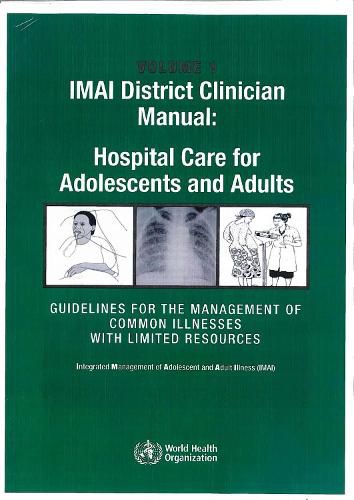Readings Newsletter
Become a Readings Member to make your shopping experience even easier.
Sign in or sign up for free!
You’re not far away from qualifying for FREE standard shipping within Australia
You’ve qualified for FREE standard shipping within Australia
The cart is loading…






This manual is written for clinicians working at the district hospital (first-level referral care) who diagnose and manage sick adolescents and adults in resource-constrained settings. It supports clinical reasoning and provides an effective clinical approach and protocols for the management of common and serious or potentially life-threatening conditions at the district hospital. The target audience thus includes doctors, clinical officers, health officers and senior nurse practitioners. It has been designed to be applicable in both high and low HIV prevalence settings.
The manual is divided into two volumes. The first volume covers emergency triage assessment and treatment, and acute care for a severely ill or injured patient for approximately the first 24 hours of care. This volume also describes the clinical procedures commonly used in this care, and gives a summary of drugs used and the steps necessary for infection control.
Volume 2 provides a symptom-based approach to clinical care for acute and subacute conditions (including mental health), short summaries of the management of diseases which affect multiple systems of the body, focusing on communicable diseases, and the chronic or long-term management of HIV, TB, alcohol and substance use disorders. Future editions may incorporate the chronic management of non-communicable diseases.
The manual was developed to support clinicians to diagnose and manage adolescent and adult patients at district hospitals with limited essential drugs, laboratory tests, and equipment. It is one component of the broader WHO second-level learning program and has been developed through a large collaboration of WHO departments and their experts from many countries and regions across the world. Recommendations in the manual are predominately based on recent WHO evidence-based normative guidelines developed by several departments and disease control programs. The ability to provide effective emergency care for severely ill patients, to establish a likely differential diagnosis, to provide appropriate management and then monitor the patient’s response to treatment can contribute substantially to the health of the community.
$9.00 standard shipping within Australia
FREE standard shipping within Australia for orders over $100.00
Express & International shipping calculated at checkout
This manual is written for clinicians working at the district hospital (first-level referral care) who diagnose and manage sick adolescents and adults in resource-constrained settings. It supports clinical reasoning and provides an effective clinical approach and protocols for the management of common and serious or potentially life-threatening conditions at the district hospital. The target audience thus includes doctors, clinical officers, health officers and senior nurse practitioners. It has been designed to be applicable in both high and low HIV prevalence settings.
The manual is divided into two volumes. The first volume covers emergency triage assessment and treatment, and acute care for a severely ill or injured patient for approximately the first 24 hours of care. This volume also describes the clinical procedures commonly used in this care, and gives a summary of drugs used and the steps necessary for infection control.
Volume 2 provides a symptom-based approach to clinical care for acute and subacute conditions (including mental health), short summaries of the management of diseases which affect multiple systems of the body, focusing on communicable diseases, and the chronic or long-term management of HIV, TB, alcohol and substance use disorders. Future editions may incorporate the chronic management of non-communicable diseases.
The manual was developed to support clinicians to diagnose and manage adolescent and adult patients at district hospitals with limited essential drugs, laboratory tests, and equipment. It is one component of the broader WHO second-level learning program and has been developed through a large collaboration of WHO departments and their experts from many countries and regions across the world. Recommendations in the manual are predominately based on recent WHO evidence-based normative guidelines developed by several departments and disease control programs. The ability to provide effective emergency care for severely ill patients, to establish a likely differential diagnosis, to provide appropriate management and then monitor the patient’s response to treatment can contribute substantially to the health of the community.